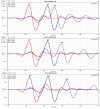Electromagnetic Differential Measuring Method: Application in Microstrip Sensors Developing
- PMID: 28718804
- PMCID: PMC5539693
- DOI: 10.3390/s17071650
Electromagnetic Differential Measuring Method: Application in Microstrip Sensors Developing
Abstract
Electromagnetic radiation is energy that interacts with matter. The interaction process is of great importance to the sensing applications that characterize material media. Parameters like constant dielectric represent matter characteristics and they are identified using emission, interaction and reception of electromagnetic radiation in adapted environmental conditions. How the electromagnetic wave responds when it interacts with the material media depends on the range of frequency used and the medium parameters. Different disciplines use this interaction and provides non-intrusive applications with clear benefits, remote sensing, earth sciences (geology, atmosphere, hydrosphere), biological or medical disciplines use this interaction and provides non-intrusive applications with clear benefits. Electromagnetic waves are transmitted and analyzed in the receiver to determine the interaction produced. In this work a method based in differential measurement technique is proposed as a novel way of detecting and characterizing electromagnetic matter characteristics using sensors based on a microstrip patch. The experimental results, based on simulations, show that it is possible to obtain benefits from the behavior of the wave-medium interaction using differential measurement on reception of electromagnetic waves at different frequencies or environmental conditions. Differential method introduce advantages in measure processes and promote new sensors development. A new microstrip sensor that uses differential time measures is proposed to show the possibilities of this method.
Keywords: differential measurement; dispersive media; microstrip sensor; multifrequency treatment; remote sensing.
Conflict of interest statement
The authors declare no conflict of interest.
Figures















References
-
- Kerle N. Encyclopedia of Natural Hazards. Springer; Dordrecht, The Netherlands: 2013. Chapter Electromagnetic Radiation (EMR) p. 250.
-
- Pastor F.J.F., Chamizo J.M.G., Nieto-Hidalgo M. Electromagnetic Multi-frequency Model and Differential Measuring in Remote Sensing Applications; Proceedings of the International Conference on Ubiquitous Computing and Ambient Intelligence (UCAmI); Las Palmas de Gran Canaria, Spain. 29 November–2 December 2016.
-
- Davis J.L., Annan A.P. Ground-penetration radar for high-resolution mapping of soil and rock stratigraphy. Geophys. Prospect. 1989;37:531–551. doi: 10.1111/j.1365-2478.1989.tb02221.x. - DOI
-
- Huston D., Xia T., Zhang Y., Fan T., Razinger J., Burns D. Transforming the Future of Infrastructure through Smarter Information, International Conference on Smart Infrastructure and Construction, Robinson College, CA, USA, 27–29 June 2016. ICE Publishing; London, UK: 2016. Tri-band ground penetrating radar for subsurface structural condition assessments and utility mapping; pp. 283–287.
-
- Doviak R.J., Zrnic D.S. Doppler Radar & Weather Observations. Academic Press; Cambridge, MA, USA: 2014.
LinkOut - more resources
Full Text Sources
Other Literature Sources

